Motorola Solutions 89FC5809 900 MHz Fixed Wireless (ISM) User Manual Canopy 900 MHz User Guide Issue 2
Motorola Solutions, Inc. 900 MHz Fixed Wireless (ISM) Canopy 900 MHz User Guide Issue 2
Contents
- 1. Exh D Manual
- 2. Updated Users Manual
Updated Users Manual
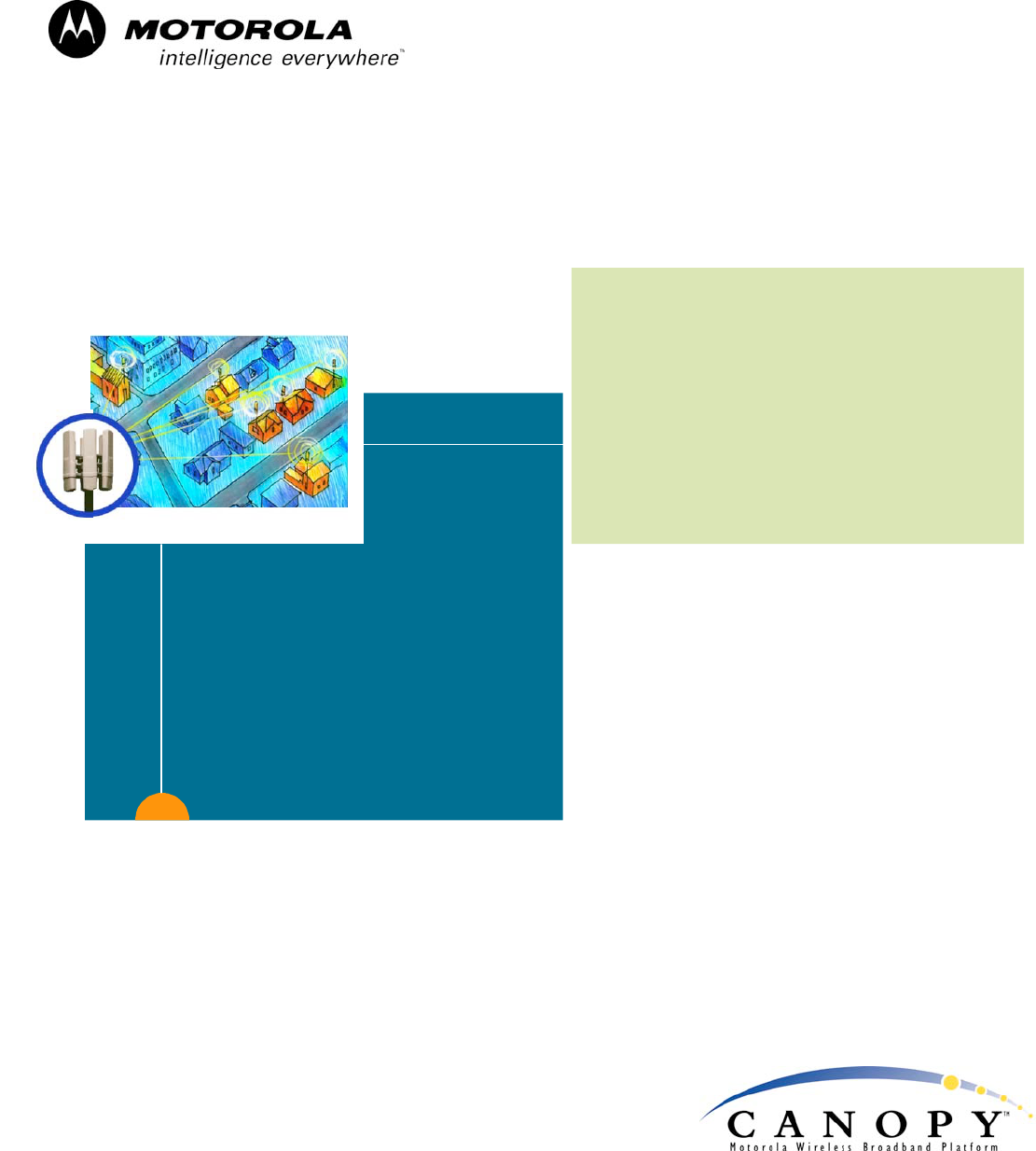
900-UG-en
Issue 2
August 2004
CanopyTM 900 MHz
Access Point (AP) and
Subscriber Module (SM)
User Guide
Software Release Notes

Canopy 900 MHz AP and SM User Guide
Issue 2 August, 2004 Page 2 of 16
NOTICES
Important Note on Modifications
Intentional or unintentional changes or modifications to the equipment must not be made unless under the express consent of the party
responsible for compliance. Any such modifications could void the user’s authority to operate the equipment and will void the
manufacturer’s warranty.
U.S. Federal Communication Commission (FCC) and Industry Canada (IC) Notification
This device complies with part 15 of the U. S. FCC Rules and Regulations and with RSS-210 of Industry Canada. Operation is
subject to the following two conditions: (1) This device may not cause harmful interference, and (2) This device must accept any
interference received, including interference that may cause undesired operation.
This equipment has been tested and found to comply with the limits for a Class B digital device, pursuant to Part 15 of the U.S. FCC
Rules and with RSS-210 of Industry Canada. These limits are designed to provide reasonable protection against harmful interference
in a residential installation. This equipment generates, uses, and can radiate radio-frequency energy and, if not installed and used in
accordance with these instructions, may cause harmful interference to radio communications. If this equipment does cause harmful
interference to radio or television reception, which can be determined by turning the equipment on and off, the user is encouraged to
correct the interference by one or more of the following measures:
• Increase the separation between the affected equipment and the unit;
• Connect the affected equipment to a power outlet on a different circuit from that which the receiver is connected to;
• Consult the dealer and/or experienced radio/TV technician for help.
This device has been certifed with Industy Canada to operate with an antenna having a maximum gain of 10 dBi. Using an antenna
having a higher gain is strictly prohibited per regulations of Industry Canada. The required antenna impedance is 50 ohms. To reduce
potential radio interference to other users, Industry Canada requires the antenna type and its gain be chosen so that the equivalent
isotropically radiated power (EIRP) is not more than that required for successful communication.
FCC IDs and Industry Canada Certification Numbers are listed in the following table:
Module
Types
Operating Frequency
Range
RMS Power
Reflector or Antenna
FCC ID
Industry Canada
Certification
Number
SM AP
ISM 902 to 928 MHz
Up to 0.4 W
(26 dBm)
Maxrad Model # Z1681, flat panel
with 10 dBi gain
Mars Model # MA-IS91-T2, flat
panel with10 dBi gain
MTI Model #MT-2630003/N, flat
panel with 10 dBi gain
ABZ89FC5809
109W-9000ISM
Exposure Note
The antenna of a Canopy 900 MHz module must be installed to provide a separation distance of at least 60 cm (approx 24 inches)
from all persons. When so installed, the module’s RF field is within Health Canada limits for the general population; consult Safety
Code 6, obtainable from Health Canada’s website http://www.hc-sc.gc.ca/rpb. Per Health Canada Safety Code 6, the installer of this
radio equipment must ensure that the antenna is located or pointed such that it does not emit RF field in excess of Health Canada
limits for the general population.
Currently certified 900 MHz antennas have an antenna gain of 10 dBi, which means they are limited to a maximum RMS power of 0.4
W (26 dBm) to remain within the regulatory limit of 4 W (36 dBm) for the 900 MHz frequency band.
The applicable power density exposure limit for radios operating in the 900 MHz frequency band is 6 Watt/m2, according to the FCC
OET Bulletin 65, the ICNIRP guidelines, and the Health Canada Safety Code 6. The corresponding compliance distances referenced
above have been determined by assuming worst-case scenarios. The peak power density (S) in the far-field of a radio-frequency source
with rms transmit power P and antenna gain G at a distance d is
2
4d
GP
S
π
⋅
=
In the case of a 900 MHz Canopy SM or AP with an antenna gain of 10 dBi (a factor of 10) and correctly entered in the user interface
as a 10 dBi antenna, the peak power density equals the exposure limit at a distance of 23 cm. A power compliance margin of nearly 7
times is artificially introduced by setting the distance to 60 cm.
The compliance distance is greatly overestimated in these cases because the far-field equation neglects the physical dimension of the
antenna, which is modeled as a point-source.
Software License Terms and Conditions
Canopy 900 MHz AP and SM User Guide
Issue 2 August, 2004 Page 3 of 16
ONLY OPEN THE PACKAGE, OR USE THE SOFTWARE AND RELATED PRODUCT IF YOU ACCEPT THE TERMS OF
THIS LICENSE. BY BREAKING THE SEAL ON THIS DISK KIT / CDROM, OR IF YOU USE THE SOFTWARE OR RELATED
PRODUCT, YOU ACCEPT THE TERMS OF THIS LICENSE AGREEMENT. IF YOU DO NOT AGREE TO THESE TERMS, DO
NOT USE THE SOFTWARE OR RELATED PRODUCT; INSTEAD, RETURN THE SOFTWARE TO PLACE OF PURCHASE
FOR A FULL REFUND. THE FOLLOWING AGREEMENT IS A LEGAL AGREEMENT BETWEEN YOU (EITHER AN
INDIVIDUAL OR ENTITY), AND MOTOROLA, INC. (FOR ITSELF AND ITS LICENSORS). THE RIGHT TO USE THIS
PRODUCT IS LICENSED ONLY ON THE CONDITION THAT YOU AGREE TO THE FOLLOWING TERMS.
Now, therefore, in consideration of the promises and mutual obligations contained herein, and for other good and valuable
consideration, the receipt and sufficiency of which are hereby mutually acknowledged, you and Motorola agree as follows:
Grant of License. Subject to the following terms and conditions, Motorola, Inc., grants to you a personal, revocable, non-assignable,
non-transferable, non-exclusive and limited license to use on a single piece of equipment only one copy of the software contained on
this disk (which may have been pre-loaded on the equipment)(Software). You may make two copies of the Software, but only for
backup, archival, or disaster recovery purposes. On any copy you make of the Software, you must reproduce and include the
copyright and other proprietary rights notice contained on the copy we have furnished you of the Software.
Ownership. Motorola (or its supplier) retains all title, ownership and intellectual property rights to the Software and any copies,
including translations, compilations, derivative works (including images) partial copies and portions of updated works. The Software
is Motorola’s (or its supplier's) confidential proprietary information. This Software License Agreement does not convey to you any
interest in or to the Software, but only a limited right of use. You agree not to disclose it or make it available to anyone without
Motorola’s written authorization. You will exercise no less than reasonable care to protect the Software from unauthorized disclosure.
You agree not to disassemble, decompile or reverse engineer, or create derivative works of the Software, except and only to the extent
that such activity is expressly permitted by applicable law.
Termination. This License is effective until terminated. This License will terminate immediately without notice from Motorola or
judicial resolution if you fail to comply with any provision of this License. Upon such termination you must destroy the Software, all
accompanying written materials and all copies thereof, and the sections entitled Limited Warranty, Limitation of Remedies and
Damages, and General will survive any termination.
Limited Warranty. Motorola warrants for a period of ninety (90) days from Motorola’s or its customer’s shipment of the Software to
you that (i) the disk(s) on which the Software is recorded will be free from defects in materials and workmanship under normal use
and (ii) the Software, under normal use, will perform substantially in accordance with Motorola’s published specifications for that
release level of the Software. The written materials are provided "AS IS" and without warranty of any kind. Motorola's entire liability
and your sole and exclusive remedy for any breach of the foregoing limited warranty will be, at Motorola's option, replacement of the
disk(s), provision of downloadable patch or replacement code, or refund of the unused portion of your bargained for contractual
benefit up to the amount paid for this Software License.
THIS LIMITED WARRANTY IS THE ONLY WARRANTY PROVIDED BY MOTOROLA, AND MOTOROLA AND ITS
LICENSORS EXPRESSLY DISCLAIM ALL OTHER WARRANTIES, EITHER EXPRESS OF IMPLIED, INCLUDING BUT
NOT LIMITED TO IMPLIED WARRANTIES OF MERCHANTABILITY AND FITNESS FOR A PARTICULAR PURPOSE AND
NONINFRINGEMENT. MOTOROLA DOES NOT WARRANT THAT THE OPERATION OF THE SOFTWARE WILL BE
UNINTERRUPTED OR ERROR-FREE, OR THAT DEFECTS IN THE SOFTWARE WILL BE CORRECTED. NO ORAL OR
WRITTEN REPRESENTATIONS MADE BY MOTOROLA OR AN AGENT THEREOF SHALL CREATE A WARRANTY OR
IN ANY WAY INCREASE THE SCOPE OF THIS WARRANTY. MOTOROLA DOES NOT WARRANT ANY SOFTWARE
THAT HAS BEEN OPERATED IN EXCESS OF SPECIFICATIONS, DAMAGED, MISUSED, NEGLECTED, OR IMPROPERLY
INSTALLED. BECAUSE SOME JURISDICTIONS DO NOT ALLOW THE EXCLUSION OR LIMITATION OF IMPLIED
WARRANTIES, THE ABOVE LIMITATIONS MAY NOT APPLY TO YOU.
Limitation of Remedies and Damages. Regardless of whether any remedy set forth herein fails of its essential purpose, IN NO
EVENT SHALL MOTOROLA OR ANY OF THE LICENSORS, DIRECTORS, OFFICERS, EMPLOYEES OR AFFILIATES OF
THE FOREGOING BE LIABLE TO YOU FOR ANY CONSEQUENTIAL, INCIDENTAL, INDIRECT, SPECIAL OR SIMILAR
DAMAGES WHATSOEVER (including, without limitation, damages for loss of business profits, business interruption, loss of
business information and the like), whether foreseeable or unforeseeable, arising out of the use or inability to use the Software or
accompanying written materials, regardless of the basis of the claim and even if Motorola or a Motorola representative has been
advised of the possibility of such damage. Motorola's liability to you for direct damages for any cause whatsoever, regardless of the
basis of the form of the action, will be limited to the price paid for the Software that caused the damages. THIS LIMITATION WILL
NOT APPLY IN CASE OF PERSONAL INJURY ONLY WHERE AND TO THE EXTENT THAT APPLICABLE LAW
REQUIRES SUCH LIABILITY. BECAUSE SOME JURISDICTIONS DO NOT ALLOW THE EXCLUSION OR LIMITATION
OF LIABILITY FOR CONSEQUENTIAL OR INCIDENTAL DAMAGES, THE ABOVE LIMITATION MAY NOT APPLY TO
YOU.
Maintenance and Support. Motorola shall not be responsible for maintenance or support of the software. By accepting the license
granted under this agreement, you agree that Motorola will be under no obligation to provide any support, maintenance or service in
connection with the Software or any application developed by you. Any maintenance and support of the Related Product will be
provided under the terms of the agreement for the Related Product.
Transfer. In the case of software designed to operate on Motorola equipment, you may not transfer the Software to another party
except: (1) if you are an end-user, when you are transferring the Software together with the Motorola equipment on which it operates;
or 2) if you are a Motorola licensed distributor, when you are transferring the Software either together with such Motorola equipment

Canopy 900 MHz AP and SM User Guide
Issue 2 August, 2004 Page 4 of 16
or are transferring the Software as a licensed duly paid for upgrade, update, patch, new release, enhancement or replacement of a prior
version of the Software. If you are a Motorola licensed distributor, when you are transferring the Software as permitted herein, you
agree to transfer the Software with a license agreement having terms and conditions no less restrictive than those contained herein.
You may transfer all other Software, not otherwise having an agreed restriction on transfer, to another party. However, all such
transfers of Software are strictly subject to the conditions precedent that the other party agrees to accept the terms and conditions of
this License, and you destroy any copy of the Software you do not transfer to that party. You may not sublicense or otherwise
transfer, rent or lease the Software without our written consent. You may not transfer the Software in violation of any laws,
regulations, export controls or economic sanctions imposed by the U.S. Government.
Right to Audit. Motorola shall have the right to audit annually, upon reasonable advance notice and during normal business hours,
your records and accounts to determine compliance with the terms of this Agreement.
Export Controls. You specifically acknowledge that the software may be subject to United States and other country export control
laws. You shall comply strictly with all requirements of all applicable export control laws and regulations with respect to all such
software and materials.
U.S. Government Users. If you are a U.S. Government user, then the Software is provided with "RESTRICTED RIGHTS" as set
forth in subparagraphs (c)(1) and (2) of the Commercial Computer Software-Restricted Rights clause at FAR 52 227-19 or
subparagraph (c)(1)(ii) of the Rights in Technical Data and Computer Software clause at DFARS 252.227-7013, as applicable.
Disputes. You and Motorola hereby agree that any dispute, controversy or claim, except for any dispute, controversy or claim
involving intellectual property, prior to initiation of any formal legal process, will be submitted for non-binding mediation, prior to
initiation of any formal legal process. Cost of mediation will be shared equally. Nothing in this Section will prevent either party from
resorting to judicial proceedings, if (i) good faith efforts to resolve the dispute under these procedures have been unsuccessful, (ii) the
dispute, claim or controversy involves intellectual property, or (iii) interim relief from a court is necessary to prevent serious and
irreparable injury to that party or to others.
General. Illinois law governs this license. The terms of this license are supplemental to any written agreement executed by both
parties regarding this subject and the Software Motorola is to license you under it, and supersedes all previous oral or written
communications between us regarding the subject except for such executed agreement. It may not be modified or waived except in
writing and signed by an officer or other authorized representative of each party. If any provision is held invalid, all other provisions
shall remain valid, unless such invalidity would frustrate the purpose of our agreement. The failure of either party to enforce any rights
granted hereunder or to take action against the other party in the event of any breach hereunder shall not be deemed a waiver by that
party as to subsequent enforcement of rights or subsequent action in the event of future breaches.
Hardware Warranty in U.S.
Motorola U.S. offers a warranty covering a period of 1 year from the date of purchase by the customer. If a product is found defective
during the warranty period, Motorola will repair or replace the product with the same or a similar model, which may be a
reconditioned unit, without charge for parts or labor.
IN NO EVENT SHALL MOTOROLA BE LIABLE TO YOU OR ANY OTHER PARTY FOR ANY DIRECT, INDIRECT,
GENERAL, SPECIAL, INCIDENTAL, CONSEQUENTIAL, EXEMPLARY OR OTHER DAMAGE ARISING OUT OF THE USE
OR INABILITY TO USE THE PRODUCT (INCLUDING, WITHOUT LIMITATION, DAMAGES FOR LOSS OF BUSINESS
PROFITS, BUSINESS INTERRUPTION, LOSS OF BUSINESS INFORMATION OR ANY OTHER PECUNIARY LOSS, OR
FROM ANY BREACH OF WARRANTY, EVEN IF MOTOROLA HAS BEEN ADVISED OF THE POSSIBILITY OF SUCH
DAMAGES. (Some states do not allow the exclusion or limitation of incidental or consequential damages, so the above exclusion or
limitation may not apply to you.) IN NO CASE SHALL MOTOROLA’S LIABILITY EXCEED THE AMOUNT YOU PAID FOR
THE PRODUCT.
Trademarks, Product Names, and Service Names
MOTOROLA, the stylized M Logo and all other trademarks indicated as such herein are trademarks of Motorola, Inc. ® Reg. U.S. Pat
& Tm. Office. Canopy is a trademark of Motorola, Inc. All other product or service names are the property of their respective
owners.
© 2004 Motorola, Inc. All rights reserved
http://www.motorola.com/canopy
Canopy 900 MHz AP and SM User Guide
Issue 2 August, 2004 Page 5 of 16
Table of Contents
1 Introduction ________________________________________________________ 6
1.1 Document Change History _______________________________________________6
1.2 Feedback on Documentation _____________________________________________6
1.3 Technical Support______________________________________________________6
2 Feature Description and Operation _____________________________________ 8
2.1 3.3 Mbps Signaling Rate _________________________________________________ 8
2.2 Network Features Identical to 5.2 GHz, 5.7 GHz, and 2.4 GHz__________________ 8
2.3 Available as AP and SM – no Backhaul ____________________________________ 8
2.4 Three non-overlapping channels __________________________________________8
2.5 Range of 40 Miles LOS, Increased Foliage Penetration NLOS __________________ 9
2.6 Modules and Antennas available _________________________________________ 10
2.7 Spectrum Analyzer ____________________________________________________ 13
2.8 Remote AP without Tower ______________________________________________ 14
2.9 900 MHz Modules Use Release 4.2.2 ______________________________________ 14
3 900 MHz AP and SM Specifications ___________________________________ 15
List of Figures
Figure 1: Highlights of 900 MHz AP Configuration Page ______________________________________ 9
Figure 2: Connectorized 900 MHz Canopy module and Flat Panel Antenna _______________________ 11
Figure 3: Additional Connectorized 900 MHz module and Flat Panel Antenna _____________________ 12
Figure 4: 900 MHz SM Spectrum Analyzer_________________________________________________ 14

Canopy 900 MHz AP and SM User Guide
Issue 2 August, 2004 Page 6 of 16
1 Introduction
This guide is designed for operators already familiar with the Canopy system who only want the “delta” or
“difference” information for the Canopy 900 MHz Access Point and Subscriber Module. The information
in this guide will be included in appropriate sections of the Canopy documentation set.
• If you are familiar with the Canopy system, want to know what is new with the 900 MHz modules,
and don’t want to search through the general Canopy manuals, this guide is for you.
• If you are new to the Canopy system or need information across all the products and frequency
bands in the Canopy family, you should use the general Canopy manuals, not this “differences” user
guide.
To ensure you have the latest user information, check the manuals section of the Canopy web site at
http://motorola.canopywireless.com/support_library.php#manual-en.
The following abbreviations are used throughout these notes:
AP
Access Point Module
SM
Subscriber Module
1.1 Document Change History
Issue 2
• Updated exposure distance calculation details (in
Notices section) - exposure separation distance remains
unchanged at 60 cm (approx 24 in).
Issue 1
• First Issue
1.2 Feedback on Documentation
We welcome your feedback on Canopy documentation. Comments on structure, content, accuracy,
completeness, or any other area are appreciated. Please send your feedback to technical-
documentation@canopywireless.com.
1.3 Technical Support
If problems arise, the Canopy support team is here to help. Here is the escalation path for resolution of a
problem:
1. Check this document.
2. Escalate the problem to your Canopy supplier.
3. Escalate the problem to Canopy Technical Support or other designated Tier 3 technical support:
Canopy Technical Support
email: technical-support@canopywireless.com
1 888 605 2552
Canopy 900 MHz AP and SM User Guide
Issue 2 August, 2004 Page 7 of 16
or
+1 217 824 9742
When you send e-mail or call, please include the following information:
• Information on your network configuration, especially IP addresses and MAC addresses.
• Version numbers of the software on the modules with problems.
Canopy 900 MHz AP and SM User Guide
Issue 2 August, 2004 Page 8 of 16
2 Feature Description and Operation
Each of the following sections describes features that are new or different or important with the
introduction of Canopy 900 MHz APs and SMs.
2.1 3.3 Mbps Signaling Rate
Description
Canopy 900 MHz AP and SM modules operate at 3.3 Mbps (compared to 10 Mbps for other Canopy
frequency bands). With Downlink Data set to 75% on the AP Configuration page, the AP supports high
throughput to an SM. As in other Canopy frequency bands, an AP has more bandwidth than an individual
SM.
Operation
Uplink and Downlink rates can be checked using the Link Test page on the AP. On an AP, select Expanded
Stats, then Link Test.
2.2 Network Features Identical to 5.2 GHz, 5.7 GHz, and 2.4 GHz
Description
Canopy 900 MHz modules run the same software and provide the same network features as all other
Canopy APs and SMs. NAT, color codes, SNMP, authentication, RSSI measurements, jitter measurements,
AP connections to a CMM2 or CMMmicro, AES option, and so on all work the same as before.
Operation
Same operation as other frequency bands.
2.3 Available as AP and SM – no Backhaul
Description
AP and SM modules are available for building 900 MHz Point to Multi-point networks. Backhauls are not
provided, as the narrower bandwidth available in the allocated 900 MHz frequency band does not lend
itself to the capacity usually desired for backhauls.
2.4 Three non-overlapping channels
Description
The Canopy 900 MHz modules provide 3 non-overlapping channels within the allocated 900 MHz
spectrum. Channels are 8 MHz wide, and can be set with RF Frequency Carrier (center of the channel) at
906, 907, 911, 915, 919, 923, or 924 MHz. For normal operation, it is recommended that the operator use
• 906 MHz for north and south facing APs
• 915 MHz for northeast and southwest facing APs
• 924 MHz for southeast and northwest facing APs
Note, this takes advantage of the spectrum available to provide 9 MHz between channel centers, 1 MHz
greater than the minimum 8 MHz channel size, for additional channel separation.
Operation
On the AP Configuration page, set the RF Frequency Carrier parameter to the desired frequency as shown
in Figure 1: Highlights of 900 MHz AP Configuration Page.
On the SM Configuration page, select/check the desired frequencies in the Custom RF Frequency Scan
Selection List.
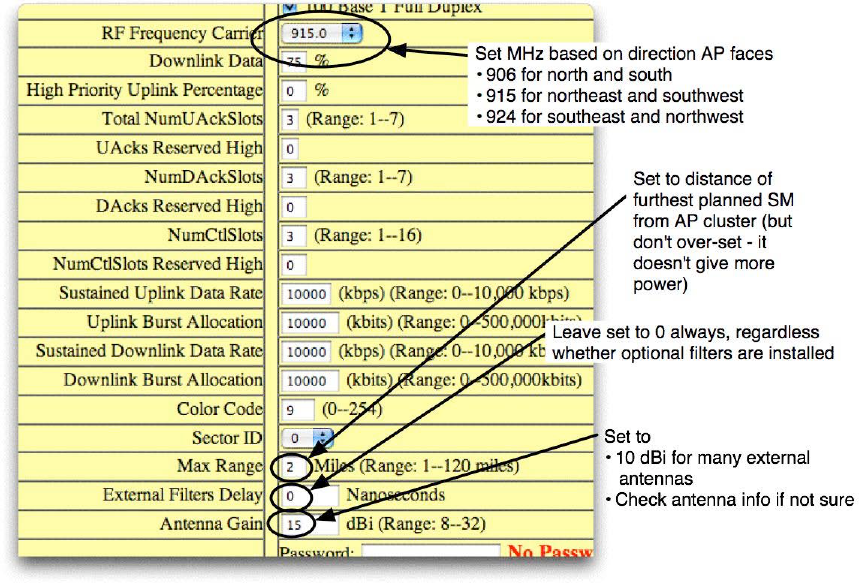
Canopy 900 MHz AP and SM User Guide
Issue 2 August, 2004 Page 9 of 16
Depending on local practices, this may mean selecting all frequencies to scan (the SM will register to any
frequency, but takes longer to scan), only one frequency to scan (forces the SM to only register to an AP on
that frequency and minimizes scan time after SM reboot), or the three recommended AP frequencies of
906, 915, and 924 MHz (allows for an SM to “switchover” to an AP on another frequency if the one it is
registered to fails or loses signal).
Figure 1: Highlights of 900 MHz AP Configuration Page
2.5 Range of 40 Miles LOS, Increased Foliage Penetration NLOS
Description
The Canopy 900 MHz modules have a Line-of-Sight (LOS) range of 40 miles (over 64 km), and increased
Non-Line-of-Sight (NLOS) range. NLOS range is dependent on foliage, topography, obstructions, and
other RF engineering considerations. The physics of longer-wavelength 900 MHz, the power allowed by
regulatory authorities, and the low Canopy Carrier-to-Interference (C/I) ratio combine to support service
over these increased LOS and NLOS ranges.
While the expected typical range in real-world conditions is 40 miles, the AP can be set for a range up to
120 miles (over 190 km) to accommodate long shots with very clear Fresnel zone (possibly due to high
tower or mountain top location) and quiet RF environment.
Setting the range higher tells the software to have a slightly longer switchover time between transmit and
receive to accommodate longer air delay. This reduces the slots per frame available for data, which slightly
reduces aggregate throughput at the AP. However, the predictability of Canopy point-to-multi-point
throughput continues. All SMs served by an AP set to a given range continue to have the same throughput
regardless of their distance from the AP.
Canopy 900 MHz AP and SM User Guide
Issue 2 August, 2004 Page 10 of 16
The 900 MHz modules complement the other frequency bands offered. The 900 MHz modules can be used
to cover a larger area, albeit with lower throughput, than the other frequency bands. Depending on specific
operator requirements, they can be used to penetrate foliage, have greater range, or add additional
subscribers or additional overall throughput to a tower that is maxed out or can’t use another frequency
band due to interference or tower rights issues.
Operation
Set the Max Range parameter on the AP Configuration page to the distance of the furthest planned SM
from the AP cluster, as shown in Figure 1: Highlights of 900 MHz AP Configuration Page.
Important!
• Don’t over-set the range. Setting the range higher does not increase the power of the AP.
• Setting the range higher can reduce aggregate throughput.
• All 900 MHz APs in a cluster must be set to the same Max Range.
2.6 Modules and Antennas available
Description
900 MHz AP and SM modules are initially available as connectorized units connecting to connectorized
antennas. The following sections describe the module and three regulatory agency certified antenna
options.
Connectorized AP or SM
A connectorized 900 MHz AP or SM uses the same housing as a 2.4, 5.2, and 5.7 GHz module and has a 16
inch (approx 40 cm) cable with a male N-type connector for connecting to the antenna. It has a covered
Ethernet port and utility port (for alignment headset, sync cable to CMM2, or override plug), the same as
2.4, 5.2, and 5.7 GHz modules. Figure 2: Connectorized 900 MHz Canopy module and Flat Panel Antenna
shows a connectorized module connected to a flat panel antenna.
Connectorized Flat Panel Antenna
Motorola offers an external antenna, as shown in Figure 2: Connectorized 900 MHz Canopy module and
Flat Panel Antenna. The attributes of this antenna include:
• 10 dBi gain
• 8.8” x 8.1” x 1.6” (22.4 x 20.6 x 4.06 cm)
• 1.2 lbs (0.54 kg)
• vertical or horizontal polarization
• 12 inch (30.5 cm) cable
• female N-type connector
• 3 dB beam width approximately 60° vertical and 60° horizontal
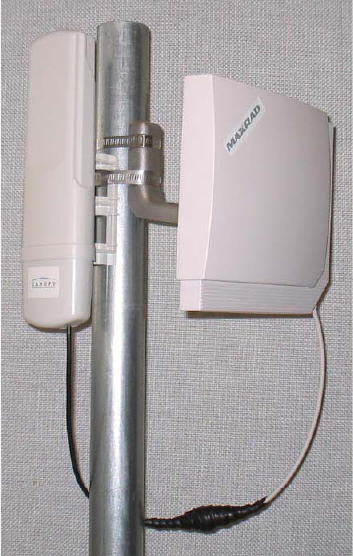
Canopy 900 MHz AP and SM User Guide
Issue 2 August, 2004 Page 11 of 16
Figure 2: Connectorized 900 MHz Canopy module and Flat Panel Antenna
Other Connectorized Flat Panel Antennas
Motorola has certified an additional two antennas that are available through Canopy resellers. Third parties
may also certify additional antennas for use with the Canopy connectorized 900 MHz module.
The attributes of one of these certified antennas (shown in Figure 3: Additional Connectorized 900 MHz
module and Flat Panel Antenna) is as follows:
• 10 dBi gain
• 12"x12"x1" (30.5 x 30.5 x 2.5 cm)
• 3.3 lbs (1.5 kg)
• vertical or horizontal polarization
• female N-type connector)
• 3 dB beam width 60° vertical and 60° horizontal
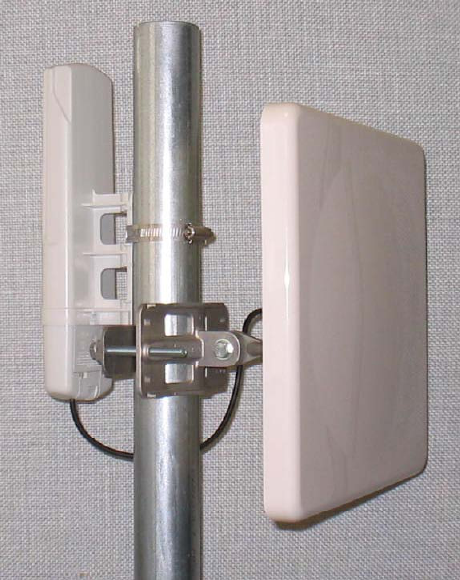
Canopy 900 MHz AP and SM User Guide
Issue 2 August, 2004 Page 12 of 16
Figure 3: Additional Connectorized 900 MHz module and Flat Panel Antenna
Operation
To install an antenna to a mast or structure, follow the antenna manufacturer’s instructions. The module
and antenna should be installed in a safe and secure manner using industry practices.
Important! The Universal Mounting Bracket available from Motorola (part number SMMB-1 and
consisting of a mounting bracket and L-shaped aluminum tube) is designed for holding one Canopy
module. It is not designed for holding both the module and a connectorized antenna.
Important! Use of connectorized antennas requires professional installation. The professional installer
is responsible for
• Selection of an antenna approved for use with the Canopy 900 MHz AP and SM by the national
regulatory agency
• Setting of the gain consistent with the antenna and within regulatory limits
• Use of moisture sealing tape or wrap to increase long-term reliability of the connectorized
connection
Enter the dBi gain of your antenna in the Antenna Gain parameter on the AP Configuration page, as shown
in Figure 1: Highlights of 900 MHz AP Configuration Page.
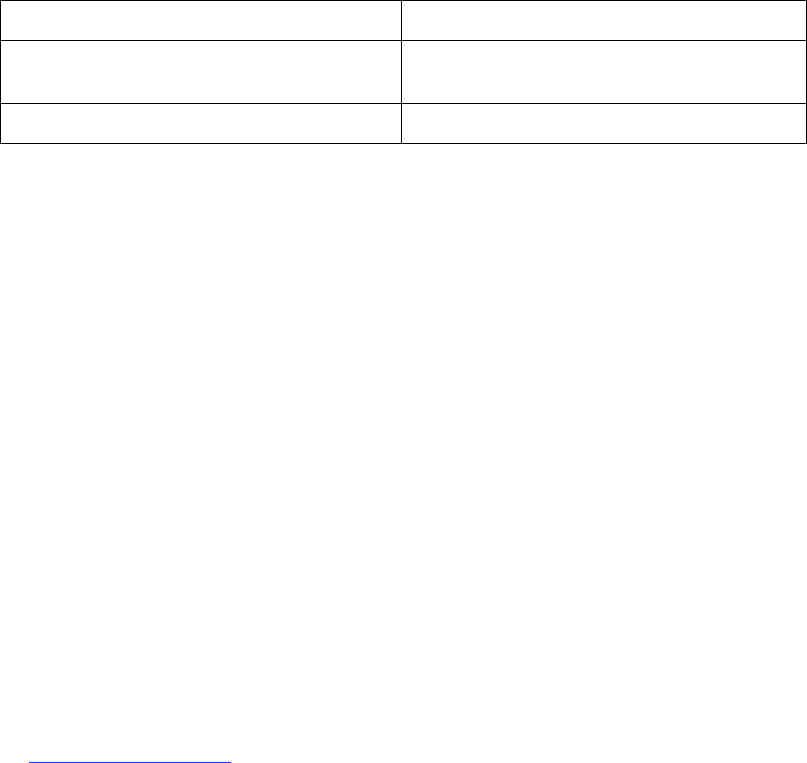
Canopy 900 MHz AP and SM User Guide
Issue 2 August, 2004 Page 13 of 16
For this antenna:
Enter this Antenna Gain:
Flat Panel antennas certified with regulatory
agencies by Motorola
10 dBi
Antenna certified by third party
Consult antenna documentation
Leave the External Filters Delay parameter on the AP Configuration page (see Figure 1: Highlights of 900
MHz AP Configuration Page) at the factory default of 0 Nanoseconds, regardless of whether you have
cavity filters. (The External Filter Delay was included in the user interface in case it was needed, but turns
out to never be needed – leave it set to 0.)
Important! To remain within the legal regulatory limits for antenna output power, you must not set the
Antenna Gain parameter lower than the actual gain of your antenna. If you have a 10 dBi antenna, do not
enter an Antenna Gain of 8 or 9. This parameter must be set equal to or higher than the actual gain of your
antenna to remain within the legal regulatory limits for antenna output power.
The parameter has a range from 8 dBi to 32 dBi. When set to 8 dBi, the radio will have a power-out of 28
dBm at the connector, which along with an 8 dBi antenna will generate the legal maximum EIRP of 36
dBm (4 W). When set to 12 dBi, the radio will have a power-out of 24 dBm at the connector, which along
with a 12 dBi antenna will generate the legal maximum EIRP of 36 dBm (4 W).
Note! In some circumstances, it may be advantageous to set the parameter higher than the actual gain of
your antenna. This reduces the power (and range) of the link, and may be useful to reduce RF power levels,
multi-pathing, and jitter in some situations.
Important! When using connectorized antennas, the connector can be a point of failure over time due
to moisture. Accepted industry practices should be used to wrap the connector to prevent water ingress.
The male and female N-type connectors form a gas tight seal with each other, but the point where the cable
enters each connector can be a point for water ingress, with eventual corrosion and failure of the
connection. Wrapping and sealing is critical to long-term reliability of the connection.
One option for a weather-tight wrap around the N-type connector is Coax-Seal, made by Universal
Electronics, http://www.coaxseal.com. Sealing material may also be provided with some antennas.
Start the wrap on the cable 0.5 to 2 inches inches (about 1.5 to 5 cm) from the connection and finish on the
cable 0.5 to 2 inches (about 1.5 to 5 cm) above the connection. See the cable in Figure 1: Highlights of 900
MHz AP Configuration Page. Note this cable has been wrapped, but not yet tied or secured against the
wind. Once done wrapping, squeeze the wrap with your hand or fingers to compress and remove any
trapped air. For abrasion resistance and appearances, premium vinyl electrical tape can be used over the
wrap.
2.7 Spectrum Analyzer
Description
The Canopy 900 MHz SM provides a spectrum analyzer much like 2.4, 5.2, and 5.7 GHz SMs, as shown in
Figure 4: 900 MHz SM Spectrum Analyzer. Due to the heavy general use of the 900 MHz spectrum, it is
advisable to use the SM’s built-in spectrum analyzer or other equipment to confirm the RF environment
both at AP and at SM locations during site surveys.
Operation
On the SM, click on Expanded Stats, then on Spectrum Analyzer. Click Enable several times to scan and
collect data, then click Disable to return the SM to normal mode.
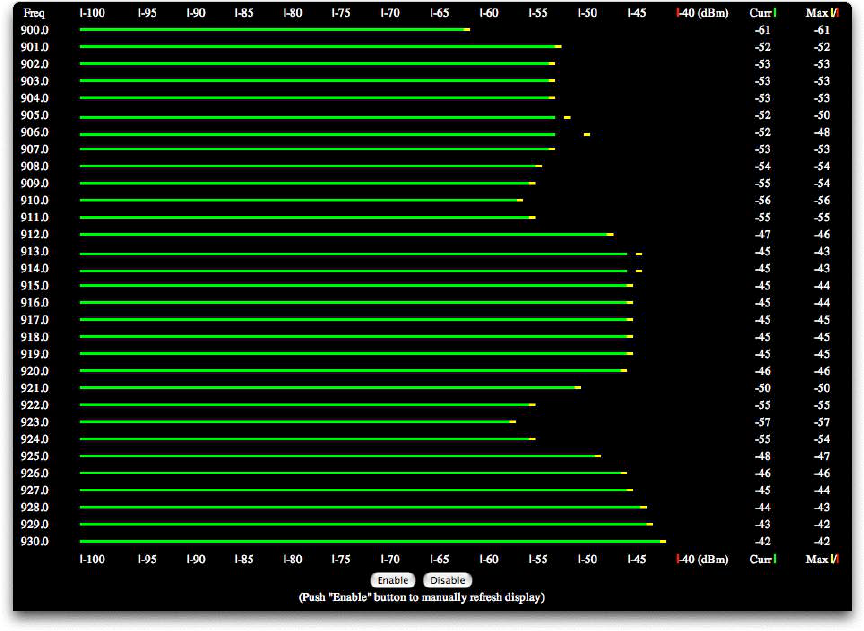
Canopy 900 MHz AP and SM User Guide
Issue 2 August, 2004 Page 14 of 16
Figure 4: 900 MHz SM Spectrum Analyzer
2.8 Remote AP without Tower
Description
A 900 MHz AP can be collocated with a 2.4, 5.2, or 5.7 GHz SM to provide a “remote AP” solution and
provide coverage to a cluster of further distant subscribers, or subscribers with foliage, with no tower
location or backhaul needed at the remote AP site. The 2.4, 5.2, or 5.7 GHz SM has to have clear LOS to its
AP, but it can be located near the ground and collocated with a 900 MHz AP that then communicates with
NLOS 900 MHz SMs. NLOS range is dependent on foliage, topography, obstructions, and other RF
engineering considerations.
2.9 900 MHz Modules Use Release 4.2.2
Description
Canopy 900 MHz APs and SMs require Canopy Software Release 4.2.2 or later, FPGA Version 051804 or
later (for DES modules), and Canopy Boot 3.0 or later. Release 4.2.2 will only be available on 900 MHz
APs and SMs and will not be available for general download off the Canopy website for use with 2.4, 5.2,
and 5.7 GHz modules. 900 MHz modules running on Release 4.2.2 are fully compatible with mixed
networks containing other frequency band modules running on older releases.

Canopy 900 MHz AP and SM User Guide
Issue 2 August, 2004 Page 15 of 16
3 900 MHz AP and SM Specifications
Specification
Canopy System Range
Frequency Band Ranges
902 to 928 MHz (ISM)
Access Method
TDD/TDMA
Signaling Rate
3.3 Mbps
Modulation Type
High-index 2-level FSK (Frequency Shift Keying)
(Optimized for interference rejection)
Carrier to Interference (C/I)
Less than 3 dB nominal
Receiver Sensitivity
-90 dBm typical
Operating Range
Up to 40 miles (64 km) Line-of Sight
Increased foliage penetration Non Line-of-Sight
Transmitter Power
Up to 0.63 W (28 dBm) (when the antenna gain is entered as 8 dBi in
the user interface)
Effective Isotropic Radiated
Power (EIRP)
Up to 4 W (36 dBm) (when the antenna gain is entered in the user
interface consistent with the actual attached antenna, for example, set to
10 dBi for a 10 dBi antenna)
Subscriber Flat Panel
Antenna
10 dBi gain.
Vertically or horizontally polarized (changed by physical position),
approximately 60° horizontal x 60° vertical 3 dB beam width.
Horizontal polarization is recommended, since most cellular and paging
systems (which use adjacent frequency bands) use vertically polarized
antennas.
DC Power (measured at DC
converter)
For both AP and SM: Typically 0.3 A @ 24 VDC (7.2 watts)
For AP: May reach 0.35 A @ 24 VDC (8.4 watts) under heavy load
(high transmit ratio (set by downlink percentage), high packet
throughput)
Ethernet, GPS sync, and GPS
coax cables
The use of cables that are rated for the operation temperature of the
product and that conform to UV light protection specifications is
mandatory. The use of shielded cables is strongly recommended,
especially on infrastructure (APs).
Interface
10/100BaseT, half/full duplex.
Rate auto-negotiated (802.3 compliant).
Protocols Used
IPv4, UDP, TCP, ICMP, Telnet, HTTP, FTP, SNMP, DES.
Optionally, AES.
Protocols Supported
Switched Layer 2 Transport with support for all common Ethernet
protocols, such as IPv6, NetBIOS, DHCP, IPX.
Software Upgrade Path
Remotely downloaded into flash memory

Canopy 900 MHz AP and SM User Guide
Issue 2 August, 2004 Page 16 of 16
Specification
Canopy System Range
Network Management
HTTP, telnet, FTP, SNMP
Wind
118 miles/hour (190 km/hour)
Operation Temperature
-40° F to +131º F (-40° C to +55° C)
Connectorized Module
Weight: 1 lb (0.45 kg)
Dimensions: 11.75” H x 3.4” W x 3.4” D (29.9 cm H x 8.6 cm W x 8.6
cm D)